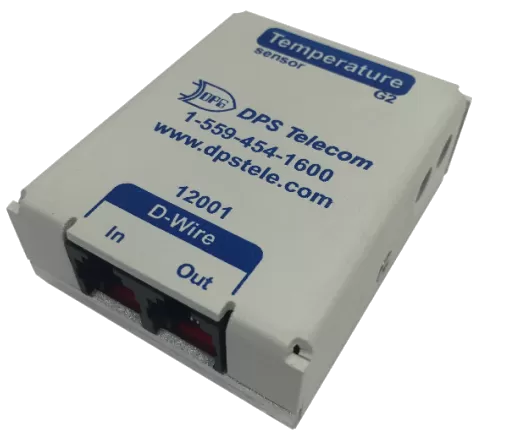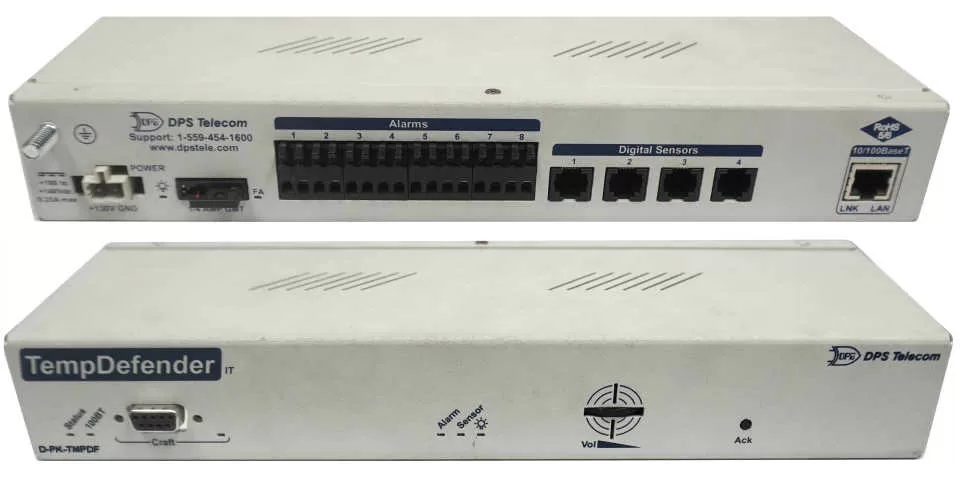Check out our White Paper Series!
A complete library of helpful advice and survival guides for every aspect of system monitoring and control.
1-800-693-0351
Have a specific question? Ask our team of expert engineers and get a specific answer!
Sign up for the next DPS Factory Training!

Whether you're new to our equipment or you've used it for years, DPS factory training is the best way to get more from your monitoring.
Reserve Your Seat TodayIn 2022 and beyond, if you want to monitor temperatures at a remote location, it's never been easier to do that. The "Internet of Things" (IoT) means that even small devices can connect to the internet and send you information.
What's important to remember is the distinction between consumer-grade solutions (involving plastic devices, batteries, and apps) and business-grade solutions (where rugged equipment reflects the importance of the job).

Let's dig into the factors you should evaluate before making a purchase decision, then talk about a few actual product options you have available:
You're here because you need something capable of remote temperature monitoring via internet. That could mean devices from under $100 to over $5000, and every price in between. There are great reasons to buy at every one of those price points.
Let's examine when you should pinch pennies, and when you should splurge.
If you're a hobbyist serving only yourself, feel free to spend as little or as much as your heart desires. Hobby projects that you might work on for networked temperature monitoring include:
For these projects, your goal is really to have fun and maybe give yourself a little piece of mind that your "fun project" is running well. You're not likely to recoup the cost of your investment, and it won't exactly be a catastrophe if you do have an undetected heat spike.
A middle ground where you can justify more spending is when you have an at-home project that will actually pay for itself over time. These can include:
As you can see, these use cases involve the actual potential for some cost savings over time. You also get important peace of mind. This isn't just for fun like "fun" projects above. These projects actually make "dollars and cents".
When your talking about vital business or government infrastructure, there's almost no reasonable limit on what you can spend for a device that measures temperature. Your mission is too important to pinch pennies. Any significant advantage you can get will likely dwarf the extra expense required.
Critical missions include:
When you're talking about facilities like this, you can't afford to mess around with cheap solutions.
You need ruggedized equipment with proven designs. You likely don't want or need a mobile app or convenient Wi-Fi.
For security purposes, you probably want wired LAN to provide your internet connection. You might not even connect to the internet at all, but instead connect to devices over your private network.
You also need to think about long-haul efficiency. Wireless sensors have some place in industrial telecom environments, but they present an additional need to replace lithium batteries at some interval.
You're likely better off if you choose wired temperature sensors whenever possible. That eliminates concerns about battery life completely.
As its name implies, the TempDefender was initially designed to focus on temperature sensing in IT and telecom environments. That continues to be a job it does well.

What makes the TempDefender a recommended choice? Let's start by reviewing the foundation:
The TempDefender RTU line is built upon the proven designs of NetGuardian RTUs. Even though the initial focus of the TempDefender was IT and data centers, no resilience was removed from the underlying NetGuardian tech. If you want proof of this, notice how it has continued to be deployed when its smaller size is a good match for a small remote hut or cabinet.
So, we have a solid platform for temperature collection and reporting. What now?
The TempDefender has a fairly compact I/O array by RTU standards, but its capacity is much higher than any consumer-grade temperature sensor.
If you want to establish remote temperature monitoring via internet, the best way to get started is to minimize unnecessary configuration steps.
Traditionally, an analog temperature sensor outputs either 0-5 VDC or 4-20 mA. This works just fine, and the TempDefender also has analog input circuits to handle this.
Unfortunately, this method also includes a lot of extra configuration steps. You have to tell the TempDefender how to understand the electrical signal and convert that to a usable temperature reading. 0 volts might be -40 degrees. 5 volts might be 180 degrees.
If you tell an RTU like the TempDefender what those 2 reference values are, it will be able to interpolate a number of degrees anywhere in that range. Still, that's an extra step.
It's much easier if you never have to set these values up at all. That's precisely what a smart sensor like a D-Wire sensor allows you to do.
Instead of needing to input reference values yourself, the small D-Wire sensor actually contains a small microprocessor with on-board firmware. It can "talk" to the TempDefender, so the TempDefender intrinsically understands the temperature readings that come back.
There are other advantages to digital communication with a sensor. Unlike traditional analog readings that are carried across lengths of plain wire, a reading that is digitized at the sensor itself is immune to degradation along the way. The accuracy of your temperature reading will go up.
You can also choose to order a sensor that also has humidity sensing built into the same physical size.
In the case of D-Wire sensors, they are also bus-powered. That means you don't have to figure out a separate way to power the sensor. Data and power are carried within the same cable.
Obviously, there are a whole host of advantages to working with something digital like D-Wire. That's hardly your only option, however.
Analog input circuits were the standard in industrial monitoring settings for decades. There's certainly nothing wrong with using them, especially if you have older RTUs that still function that you can use for the job.
Just be ready to provide power to the sensor on your own and do a little configuration.
So far, I've only really talked about analog sensors that tell you "how much?" information about remote heat levels. That tells you a lot about the state of temperature sensing.
We tend to assume in 2022 that all remote temperature sensing via internet is just naturally going to involve analog readings. Truthfully, it really should be that way.
Discrete inputs on an RTU like the TempDefender are great for a lot of things. Door alarms, for example, are binary events. You need to know if a site door is open or closed, but you don't really need to know if it's ajar at 30 degrees or 55 degrees.
Temperature can also be monitored in this way. Think of a home thermostat. You choose a level that should trigger the activation of your air conditioner or heating system.

When your thermostat detects that the temperature is above or below that threshold value, you hear the "click" that activates a response from your heating/cooling infrastructure. The heater/cooler itself doesn't know how hot or cold it is, only that it is "too hot" or "too cold".
This is very similar to monitoring discrete temperature sensors remotely. You can often literally turn a dial to set an important temperature threshold. You'll always know if temperatures are above or below that level, but never "how much?"
Consider this before choosing discrete temperature sensing, as the cost savings are pretty minimal.
Now that we have a solid far-end combo of RTU and temperature sensors, we need some way to send the data across the internet (or internal LAN) to have a complete monitoring system.
You'll do this in one of two ways. Following on with our TempDefender example, that RTU includes a web interface for both configuration and monitoring.
Using the web interface, you can check the reading from your temperature sensor(s) at any time. You can also configure threshold that will trigger "yellow alert" and "red alert" displays.
This works, but we need more. Why should you constantly have to check a web interface. Any good monitoring system needs to send you alerts. There are several common formats:
The TempDefender, like most modern RTUs, can send direct email alerts when temperatures get out of spec. Emails can be used to trigger SMS messages to your phone.
This works well at smaller organizations, but not at bigger ones. At larger companies/agencies, you need M2M (machine-to-machine) communication. To do this, RTUs like the TempDefender support SNMP.
With SNMP, you'll see messages from many devices on a single "manager" server.
Whatever you want to do with temperature monitoring, I'm here to help you figure it out. Obviously, DPS operates to serve businesses. Even so, I'll gladly help you find a consumer-grade solution if you need it.
Just give me a call at 559-454-1600 to get started. You can also send me an email at sales@dpstele.com.

Andrew Erickson
Andrew Erickson is an Application Engineer at DPS Telecom, a manufacturer of semi-custom remote alarm monitoring systems based in Fresno, California. Andrew brings more than 18 years of experience building site monitoring solutions, developing intuitive user interfaces and documentation, and opt...